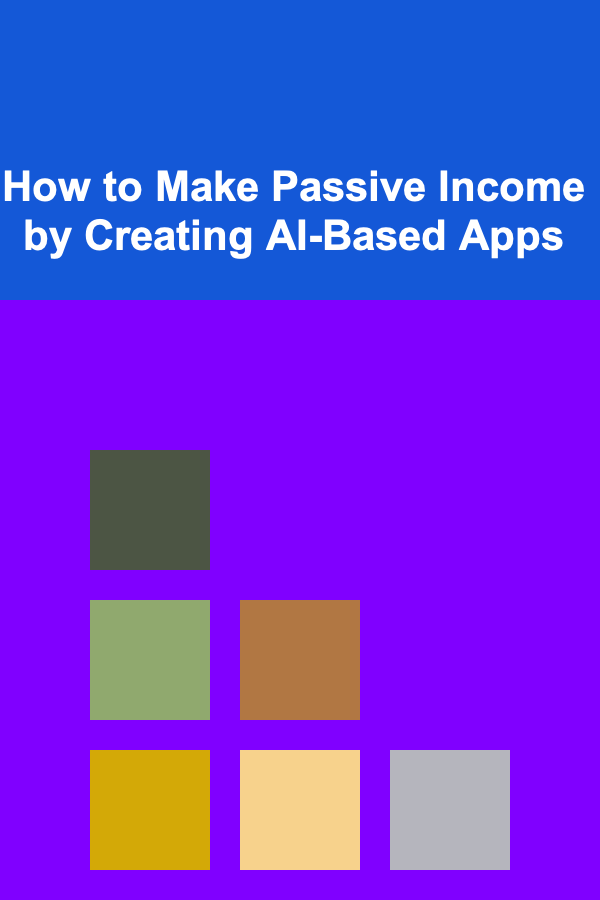
How to Make Passive Income by Creating AI-Based Apps
ebook include PDF & Audio bundle (Micro Guide)
$12.99$6.99
Limited Time Offer! Order within the next:

The advent of artificial intelligence (AI) has revolutionized many industries, presenting a wealth of opportunities for developers, entrepreneurs, and creators to build AI-based applications that can generate passive income. Whether you're a seasoned developer or a budding entrepreneur, leveraging AI for passive income can be a highly lucrative and sustainable strategy. This article will explore how you can make passive income by creating AI-based apps, detailing practical steps, strategies, and important considerations for success.
The Power of AI and Passive Income
Artificial intelligence is no longer a buzzword --- it's a transformative force that has permeated virtually every sector, from healthcare and finance to entertainment and retail. AI can analyze vast amounts of data, make predictions, automate tasks, and even create content, making it an invaluable tool for creating innovative and user-friendly applications.
What makes AI-based apps particularly attractive for passive income is their ability to operate autonomously once created. While initial development efforts may require significant time and resources, AI applications can continue to generate revenue with minimal ongoing intervention, creating a source of passive income.
By designing AI-powered apps that solve real-world problems, meet specific user needs, and offer a smooth user experience, developers can tap into a growing market that is eager for AI-driven solutions.
Step 1: Identifying a Market Need
Before diving into the development of an AI-based app, it's crucial to identify a market need. A successful passive-income app often solves a specific problem for a target audience. It's essential to conduct thorough market research to pinpoint problems that can be effectively addressed using AI.
1.1 Finding High-Demand Areas for AI Solutions
AI can be applied to a wide range of industries, but the most profitable AI applications often cater to high-demand, underserved areas. Some promising areas for AI-powered applications include:
- Healthcare: AI can help with early diagnosis, predictive analytics, and personalized treatment plans. AI-based apps in healthcare can also assist in monitoring patient data, offering recommendations, or tracking mental health.
- Finance: AI-driven apps can help individuals and businesses with investment advice, portfolio management, fraud detection, and credit scoring.
- Customer Support: AI chatbots and virtual assistants are in high demand to automate customer service tasks. An app that can help businesses manage customer queries efficiently using AI can be very profitable.
- E-commerce: Personalized shopping experiences, recommendation systems, and inventory management can be improved with AI.
- Education: AI can enhance learning experiences by providing personalized tutoring, automating assessments, and analyzing student performance.
- Content Creation: AI tools for generating articles, videos, and music are increasingly popular, offering potential for monetization through subscription or licensing models.
Understanding the specific needs of your target market and the kinds of AI tools they would value is the foundation for building an app that has a real chance of generating consistent passive income.
1.2 Defining the Target Audience
Once you've identified a market need, the next step is to define your target audience. Who will benefit from your app? Understanding your audience will help you design the app to meet their specific needs and preferences. Targeting niche groups with specialized AI tools can be a great way to stand out from the competition and build a loyal customer base.
Step 2: Selecting the Right AI Technology for Your App
AI is a broad field, and selecting the right technology for your app is key to its success. Depending on the problem you're trying to solve, there are different AI techniques and models that you can utilize.
2.1 Types of AI Techniques
Some common AI techniques that are used in app development include:
- Machine Learning (ML): Machine learning algorithms allow your app to improve over time by analyzing user data and learning from patterns. For example, recommendation systems like those on Netflix and Amazon use machine learning to suggest content based on user preferences.
- Natural Language Processing (NLP): NLP is used in AI applications that understand and generate human language. It's useful for chatbots, voice assistants, and apps that need to process text or speech, such as language translation or sentiment analysis.
- Computer Vision: This technology allows your app to interpret visual information. It's especially useful in apps for image recognition, object detection, and facial recognition.
- Reinforcement Learning: Reinforcement learning can be applied in environments where the app needs to make decisions and learn from its actions. This can be used in areas like gaming, robotics, and optimization problems.
- Generative AI: This includes generative models like GPT (which powers ChatGPT) for text generation, DALL·E for image generation, and other AI systems that create content, making it ideal for applications like writing assistants, art generation, or even video creation.
2.2 Choosing the Right Platform and Tools
The tools you use to build your AI app will depend on the type of app you're developing. Many platforms and frameworks are available to simplify AI development:
- TensorFlow: An open-source framework developed by Google, TensorFlow is one of the most widely used machine learning libraries for building and training models.
- PyTorch: PyTorch is another popular open-source library, particularly known for its ease of use and flexibility.
- OpenAI API: OpenAI offers an API that developers can use to integrate language models like GPT-4 into their apps, providing a ready-made solution for natural language generation tasks.
- Google Cloud AI: Google offers a range of AI tools that can help with everything from machine learning to NLP, making it easier to integrate advanced AI capabilities into your apps.
- IBM Watson: Watson offers a suite of AI tools for everything from speech recognition to visual analysis, perfect for building intelligent applications.
Choosing the right AI tools can significantly reduce the complexity of app development, allowing you to focus on creating a great user experience and refining the AI models that power your app.
Step 3: Building the AI App
The next step is to actually develop the AI-powered app. This process involves several stages, from designing the app's user interface (UI) and user experience (UX) to training and fine-tuning your AI models.
3.1 Design the User Experience
An AI-powered app should offer a smooth, user-friendly experience. Since many AI features operate in the background, users may not be familiar with how AI works, so it's essential to keep the interface intuitive. Here are some best practices:
- Simplify Interaction: Use conversational interfaces like chatbots for natural interactions, especially when implementing NLP.
- Provide Transparency: If your app is using AI to make decisions, make sure users understand how their data is being used and how AI is influencing the results.
- Optimize Performance: AI models can be computationally expensive, so optimize your app to run efficiently, even on lower-end devices.
3.2 Train and Fine-Tune AI Models
Once you've chosen the appropriate AI techniques, you'll need to gather and prepare data to train your models. Data quality is paramount, and your models should be trained on clean, labeled datasets that represent real-world scenarios.
- Data Collection: Collect data that is relevant to the problem your app is solving. For example, if you're developing an AI-based image recognition app, you'll need a large dataset of labeled images to train the model.
- Model Training: Use machine learning frameworks like TensorFlow or PyTorch to train your model on the collected data. The more data you have, the better the model can learn and generalize.
- Fine-Tuning: Once the model is trained, it's essential to fine-tune it using techniques like hyperparameter optimization to improve performance.
3.3 Testing and Debugging
Testing your AI app is critical to ensure it works as expected. This involves checking the accuracy of the AI models and ensuring that the app's performance is consistent across different devices and environments.
- Model Testing: Evaluate the performance of your AI model on test datasets to ensure its accuracy and reliability.
- App Testing: Perform usability testing to identify any issues with the app's interface and functionality.
Step 4: Monetizing Your AI App
Once your AI app is developed, it's time to focus on monetization. There are several ways to generate passive income from your app.
4.1 Freemium Model
One of the most popular ways to monetize an AI-based app is through the freemium model. This involves offering basic features of the app for free, with the option for users to upgrade to a premium version for additional features or functionality. For example, a free AI-based app could provide basic recommendations, while the premium version offers more advanced AI capabilities or personalized insights.
4.2 Subscription Model
The subscription model is another lucrative way to monetize your AI-based app. Users pay a recurring fee for continued access to the app's features and updates. This model works particularly well for apps that provide continuous value, such as content recommendation systems, language learning tools, or health-tracking apps.
4.3 In-App Purchases
In-app purchases allow users to unlock additional features or functionality for a one-time payment. For instance, an AI-based image editing app could allow users to purchase advanced filters or editing tools.
4.4 Advertising
If your app attracts a large user base, you can also monetize it through ads. Platforms like Google AdMob allow you to display ads within your app, generating revenue based on user interactions. While this strategy works best for free apps, it can provide a steady stream of income once your app gains traction.
4.5 Licensing Your AI Model
If your AI app includes proprietary algorithms or models, you could license the underlying technology to other companies. For example, you could license your model for use in a third-party app or business solution. Licensing can generate passive income without the need to manage a large user base directly.
Step 5: Scaling and Automating Your AI App
Once your AI app is generating passive income, the next step is scaling it to increase revenue. This involves expanding your app's reach, improving its features, and automating key tasks to minimize ongoing maintenance.
5.1 Marketing Your App
To scale your app, you'll need to invest in marketing. Digital marketing techniques such as social media advertising, search engine optimization (SEO), and influencer partnerships can help you attract more users and grow your revenue stream.
5.2 Automating Operations
As your app grows, it's essential to automate processes to ensure smooth operation. This includes automating customer support using chatbots, automating data collection, and setting up automatic updates and bug fixes.
5.3 Expanding Features
Adding new features over time can help retain users and encourage new sign-ups. Listen to user feedback and continually improve your app's AI capabilities to stay ahead of the competition.
Conclusion
Creating AI-based apps offers an exciting opportunity for developers to generate passive income. By identifying market needs, selecting the right AI technologies, building high-quality apps, and monetizing them effectively, developers can build sustainable and profitable businesses. Whether through licensing, subscriptions, or freemium models, AI-powered apps offer multiple ways to generate income while making an impact in industries that are being transformed by artificial intelligence.
Reading More From Our Other Websites
- [Weaving Tip 101] Innovations in Weaving Technology: Smart Looms and Automated Jacquard Systems
- [Metal Stamping Tip 101] Common Defects in Sheet Metal Stamping and How to Prevent Them
- [Organization Tip 101] How to Tackle Common Home Repairs with DIY Solutions
- [Screen Printing Tip 101] Best Approaches to Integrate Digital Mock‑up Software in Screen Printing Design Processes
- [Home Staging 101] How to Stage a Home for Different Architectural Styles
- [Home Family Activity 101] How to Plan Family Movie Night Themes for Themed Entertainment
- [Personal Finance Management 101] How to Optimize Personal Finance for Small Business Owners to Boost Profitability and Security
- [Home Soundproofing 101] How to Use Soundproof Curtains to Block Out External Noise
- [Personal Care Tips 101] How to Transition to Aluminum-Free Antiperspirants
- [Home Cleaning 101] How to Clean and Care for Hardwood Floors

How to Train Your Dog to Be a Home Security Asset
Read More
How to Utilize Breaks for Better Focus and Productivity
Read More
The Value of Certifications: Which Ones Are Worth Pursuing?
Read More
How to Support Wildlife Conservation Education in Schools
Read More
How to Improve Your Vocal Control and Breath Support: A Comprehensive Guide
Read More
How to Ace Your Nurse Practitioner Clinical Skills Exam
Read MoreOther Products

How to Train Your Dog to Be a Home Security Asset
Read More
How to Utilize Breaks for Better Focus and Productivity
Read More
The Value of Certifications: Which Ones Are Worth Pursuing?
Read More
How to Support Wildlife Conservation Education in Schools
Read More
How to Improve Your Vocal Control and Breath Support: A Comprehensive Guide
Read More